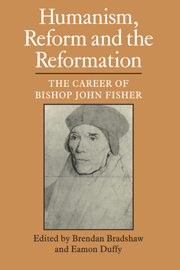Book contents
- Frontmatter
- Contents
- Preface
- List of abbreviations
- Bishop John Fisher, 1469–1535: the man and his work
- John Fisher and the promotion of learning
- The University chancellor
- The bishop in his diocese
- Fisher and Erasmus
- Fisher and More: a note
- The polemical theologian
- Fisher's view of the Church
- Fisher, Henry VIII and the Reformation crisis
- Royal ecclesiastical supremacy
- The spirituality of John Fisher
- Appendixes
- Index
Fisher, Henry VIII and the Reformation crisis
Published online by Cambridge University Press: 04 August 2010
- Frontmatter
- Contents
- Preface
- List of abbreviations
- Bishop John Fisher, 1469–1535: the man and his work
- John Fisher and the promotion of learning
- The University chancellor
- The bishop in his diocese
- Fisher and Erasmus
- Fisher and More: a note
- The polemical theologian
- Fisher's view of the Church
- Fisher, Henry VIII and the Reformation crisis
- Royal ecclesiastical supremacy
- The spirituality of John Fisher
- Appendixes
- Index
Summary
A few facts taken almost at random from the curriculum vitae of John Fisher will be enough to demonstrate what a remarkable life his was. After an exemplary early academic career, he became vice-chancellor of his University when he was a mere 32 years old. In 1504, then aged 35, he was elected chancellor. He was re-elected chancellor annually thereafter until 1514, when the electors decided to face facts and chose him for life. He was ordained a priest at the age of 22, four years below the canonical minimum and thanks to a papal license. He became a bishop when he was 35 and was thus one of the youngest men ever to have been raised to the Bench. It was Henry VII who procured the promotion – unprompted, for once, by anyone. As he explained to his mother, the Lady Margaret, whose friend and confessor Fisher already was, there was no better way of beginning to make amends for the unworthy promotions for which he had been responsible than by nominating to Rome someone of Fisher's qualities of mind and life. Fisher is the first English bishop ever to have been put on trial for treason, found guilty and executed. He is the only English Catholic bishop to have suffered that fate. He was the first chancellor of Cambridge to be so treated, but not the last. He is the only cardinal ever to have been martyred. He had at least four separate, though overlapping, careers. First, there was Fisher at Cambridge.
- Type
- Chapter
- Information
- Humanism, Reform and the ReformationThe Career of Bishop John Fisher, pp. 155 - 168Publisher: Cambridge University PressPrint publication year: 1989



